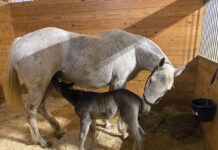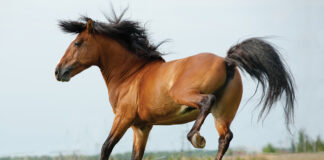
Regular hoof care is an important part of the health care routine for all horses, starting when they are young foals.
“Handle the foal every day and pick up the feet. Clean them out and simulate what the farrier is going to do,” says Roberto Gomez, DVM, a farrier in Ocala, Florida, who has been shoeing horses since 1997. “Tap on the foot or use a brush to brush the bottom of the hoof so he gets accustomed to this. If people will just work with the foal every day, this makes life easier for me, for them and for the horse, too.”
Most foals should have their first visit from the farrier at the age of one to two months old, unless your veterinarian recommends earlier attention. Correct trimming helps build a solid foundation for the foal’s developing feet and legs. Potential problems may be avoided by paying close attention to the young horse’s hoof care.
“You can actually correct some things and make changes with less risk of problems at early age,” says Gomez. “If the foal toes in or out, or is a bit club-footed, this can often be corrected if it’s addressed when the foal is young and growing.”
Some conformation problems require more than corrective trimming. For example, if the foal is extremely “over at the knee” or “down in the pasterns,” your veterinarian may want to use a special brace for a period of time to help the legs straighten out as they grow. In some cases, your veterinarian and farrier will need to work together when the foal has a specific problem they are trying to correct.
If the farrier is working to correct an issue, he may need to work on the feet every two to three weeks, and may only be shaping with the rasp. With a foal that has no problems, the farrier will only need to trim the hooves every four to six weeks.
Your farrier should watch the foal walk towards and away from him before and after trimming. This lets him watch how the foal places his feet and how those feet come in contact with the ground. He can observe if the foal has gait abnormalities that aren’t noticeable when the foal is just standing still.
With young foals, the farrier may only use a rasp and hoof knife. Nippers may or may not be used, depending on how much the hoof has grown since the last trim.
“The hoof is very soft when the foal is young, so you need to be careful and not do too much,” notes Gomez.
The goal is an even, balanced foot. The farrier will trim the foot to encourage it to land flat when it contacts the ground. Smoothing and shaping the hoof wall will help it become thicker and more resilient. In young foals, the sole is very thin, and the frog should not be trimmed much, if any at all.
“On a foal, I want to leave the frog natural because it’s like a sponge. All the impact goes to the frog; this stimulates circulation and helps the hoof grow,” explains Gomez. “I don’t usually start working on the frog until the horse is a yearling.”
During your young horse’s first year, it’s a good idea to take photos after each farrier visit, especially if there are problems you are trying to correct. Stand the foal up on a flat, even surface, with all four legs straight underneath him. The front and back legs should be even with each other. Take photos from both sides, front, rear, and then a close-up of the two front feet from the knees down (taken from the front) and of the two hind feet from the hocks down (taken from the rear). These photos will provide a visible record to help you keep track of changes and corrections as your foal grows and develops.





